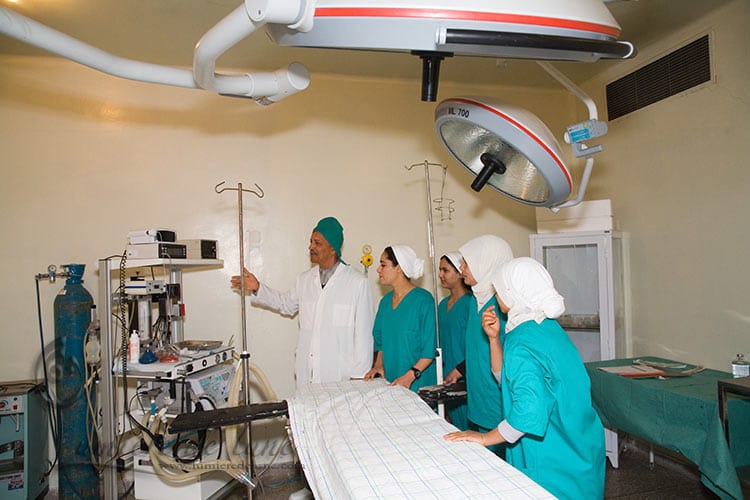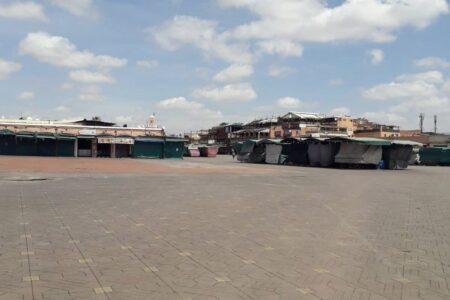The public health system in Morocco is not very efficient, so it is essential for expatriates to have a good mutual insurance company. The most effective way to cover yourself will depend on your status and the length of your planned expatriation. But before going into detail about the different options available to expatriates living in Morocco, let’s take a look at the Moroccan system.
In its logic, the Moroccan system is very similar to the French system, with differences linked to the country’s economic situation.
The CNSS is the social security fund for private-sector employees and the self-employed.
Initially, there were two funds, the CNOPS, which was responsible for the welfare of civil servants, and the CNSS, which was responsible for the scheme for private employees (and the self-employed). Since then, CNOPS beneficiaries have come under the CNSS scheme.
In 2002, health insurance (A.M.O.) became compulsory, and Moroccan companies were required to take out health insurance for their employees. It was not until 2006 that the CNSS took over responsibility for the universal basic scheme, with a renewable transitional period of five years (i.e. until 2016), during which companies that had previously taken out a policy with a private insurance company could continue with this cover.
In practice, most employees are currently registered with the CNSS. It also covers retired people receiving a pension of at least 500 dirhams a month (for a minimum wage of 2,500 dirhams a month).
Since 2020, the self-employed (liberal professions, auto-entrepreneurs, etc.) have gradually been integrated into the general scheme.
Finally, RAMED was introduced in March 2012 for people on low incomes: a maximum annual income of 5,560 dirhams per person in the household. This includes children. For a couple, this corresponds to the poverty line defined by the World Bank for Morocco ($2/day). Around 25% of the Moroccan population is covered by this supplementary scheme, which provides a minimum level of cover for people who do not benefit from A.M.O.
Contribution rates
The overall rate of contributions has been raised several times, from 26.29% in 2013 to 27.83% now.
Of this 27.83%, only 6.74% is payable by the employee, and 13.46% is capped at a contribution base of 6,000 dirhams gross per month.
| Risks | Employer’s share | Employee share | Cap | Total |
|---|---|---|---|---|
| Sickness, maternity, death, unemployment | 1.05 % | 0.52 % | 6 000 DH | 1.57 % |
| Pension | 7.93 % | 3.96 % | 6 000 DH | 11.89 % |
| Family benefits | 6.4 % | – | uncapped | 6.4 % |
| Compulsory solidarity AMO | 1.85 % | 2.26 % | uncapped | 4.11 % |
| Basic AMO | 2.26 % | – | uncapped | 2.26 % |
| Professional training | 1.6 % | – | uncapped | 1.6 % |
| Total | 21.09 % | 6.74 % | 27.83 % |
The ceiling of 6,000 dirhams represents just over twice the minimum wage (2,970 dirhams). Unlike the SMIG, it has not yet been increased.
For information purposes, here is a table comparing rates and ceilings in the main French-speaking Western countries:
| France | Belgium | Switzerland | Quebec | |
|---|---|---|---|---|
| Global contribution rate | 58% | 47.14% | 17.7% | 14.4% |
| Employer’s share | 37% | 34.07% | 9.85% | 7.58% |
| Monthly Cap | 3,086 € | uncapped | 10,500 FS | uncapped |
| Cap / Minimum wage | 2.15 | NA | NA | NA |
Who can benefit from A.M.O.?
Law 65-00 sets out the conditions for entitlement to CNSS benefits:
Entitlement to basic AMO benefits is subject to the completion of a contribution period of 54 successive or non-successive working days during the 6 months preceding the illness, effective payment of contributions by the employer, identification of the insured or pensioner’s family members with the CNSS and declaration of long and costly illnesses to the CNSS.
Clearly, in the absence of a guarantee fund, if the employer does not pay the social security contributions, the insured person will not be compensated. Many companies are very late in making these payments.
If you are an employee, you can contact your local CNSS branch to find out whether your company pays its social security contributions.
Within a month of being taken on, your employer will have registered you with the CNSS and, if you are registered for the first time, you will have received a registration card.
Loss of rights
Unemployed persons or former beneficiaries who have been insured for 1,080 consecutive days (almost three years) may take out voluntary insurance within twelve months of losing their insurance. Their benefits will have been maintained for six months.
In the event of divorce, the non-insured spouse, who was previously a beneficiary as a family member, continues to receive AMO benefits for one year. In the event of death, the beneficiaries are covered for two years.
Coverage and benefits
Cover is nowhere near as universal as in Europe. The care package includes :
- maternity care,
- care for children under the age of 12,
- follow-up of long and costly illnesses (ALC),
- monitoring of long-term conditions (ALD),
- hospitalisation.
Maternity
All care and examinations carried out during pregnancy, during and after childbirth or termination of pregnancy are covered by A.M.O.
In addition, under the Moroccan Labour Code, women are entitled to at least fourteen weeks’ maternity leave (including seven weeks after giving birth) and a maximum of twenty-four weeks in the event of illness. (Livre III, chapître II article 152 à 154 du Code du Travail)
Children under the age of twelve
Up to the age of twelve, all treatment is reimbursed. A number of compulsory examinations and vaccinations are detailed on the CNSS website.
Long-term conditions and serious and costly illnesses
Long-term conditions, or ALD (Affections longues durées) and serious and costly illnesses or ALC (Affections longues et coûteuses) Long-term illnesses and serious, costly conditions are covered in full, via the co-payment (ticket modérateur). The list is on CNSS website.
The affections include:
- diabetes (28% of cases)
- severe arterial hypertension (28% of cases)
- cancer (6% of cases)
- severe asthma (6% of cases)
- stroke (2% of cases)
- epilepsy
- Hepatitis B and C
Hospitalization
All hospital services are covered, including those provided as part of the day hospital, as well as hospital accommodation costs.
The stay itself, apart from exceptional cases, is in shared rooms for up to six patients.
Any extra cost (like a more private room) is fully supported by the patient.
Other treatments
Since February 2010, cover has been extended to other treatments:
- Medical procedures carried out by doctors, opticians and care establishments,
- Paramedical procedures,
- Biology, radiology and imaging procedures,
- Medicines prescribed by the attending physician and dispensed by pharmacists,
- Appliances.
However, except for children under the age of twelve and Ramed beneficiaries, dental care is not yet covered.
Health care reimbursements
Non-cash benefits and reimbursements
Claims for reimbursement must be made within 2 months of the first treatment. The statutory time limit for reimbursement is three months from the date on which the claim is submitted. The CNSS provides for reimbursement within one month of the end of the month.
Reimbursement is made once a month, by bank transfer or by credit card, and a statement of benefits will be sent each month in which a reimbursement is made.
Depending on the type of benefit, reimbursements will be made at 70% (other care), 70% or 90% (hospitalisation and outpatient care, in the private or public sector) or at 90% for ALC / ALD, for which exemption from co-payment is possible, bringing the rate to 100%.
Basis of reimbursement for medicines
Generally speaking, the basis for reimbursement is the price of the most expensive generic drug. If there is no generic drug, the price of the parent drug is used as the basis for reimbursement (at 70%).
Daily allowances – Work stoppage
Benefits are paid from the 4th day of absence from work in the event of illness or accident (other than occupational illness or accident). After an initial stoppage of work, the insured must pay contributions again for at least six days before he/she can receive daily benefits for another stoppage of work.
Daily benefits are equal to two-thirds of the average monthly salary on which contributions were paid during the 6 months preceding the start of the incapacity for work, and at least 2/3 of the minimum wage.
Daily allowances – Maternity leave
Daily allowances are equal to 100% of the average gross salary, subject to a ceiling of 6,000 dirhams per month. The minimum amount of these allowances may under no circumstances be less than the minimum wage. They cover the entire legal period of maternity leave.
National reference tariff
That’s all well and good, but how much is reimbursed?
Details of the reference rates can be found on the ANAM website.
It shows, among other things, that the rate for a circumcision is 420 dirhams, for a radiotherapy session 600 dirhams, and that the fixed rate for childbirth is 500 dirhams. Haemodialysis, meanwhile, costs 850 dirhams per session.
CNSS challenges
The stakes are high. For a long time, the coexistence of the old insurance systems – subscribed to by large companies – and the compulsory A.M.O. scheme deprived the CNSS of a significant proportion of its resources: mechanically, these companies had more managers and well-paid employees, and would bring in more resources than SMEs.
In addition, the financial crisis has had an impact on revenues, and many companies are significantly behind with their payments.
Finally, the extension of cover cannot be achieved without a further increase in contributions, given that the government’s objective is to raise the rate of cover for the population from 17% to 34%.
However, the powerful employers’ confederation is reluctant to switch to AMO, questioning the sustainability of the system.
Doctors, for their part, have long been calling for a substantial increase in their fees (for example, raising the fee for a practice from 80 dirhams to 150 dirhams). This was finally raised to 200 dirhams, without any change to the basis of reimbursement: patients pay more, but are still reimbursed on the basis of 80 dirhams.
Now, according to forecasts, the two organisations will be running deficits between the end of 2013 and 2016. There is therefore an urgent need to find ways of balancing the books.
Written in 2013, this post have been updated with figures and rates applicable in 2023.
 A typo or syntax error? You can select the text and hit Ctrl+Enter to send us a message. Thank you! If this post interested you, maybe you can also leave a comment. We'd love to exchange with you !
A typo or syntax error? You can select the text and hit Ctrl+Enter to send us a message. Thank you! If this post interested you, maybe you can also leave a comment. We'd love to exchange with you !




